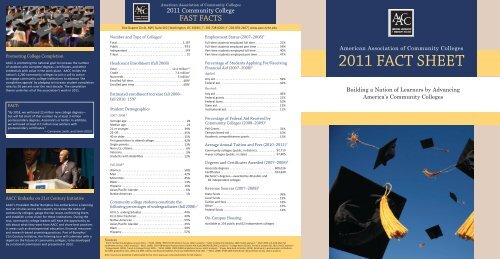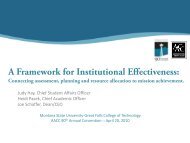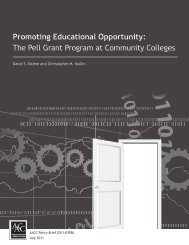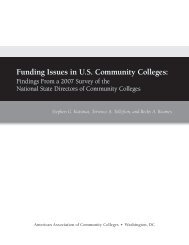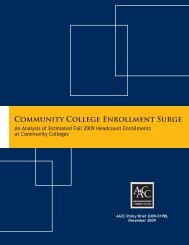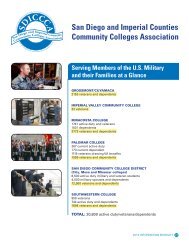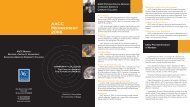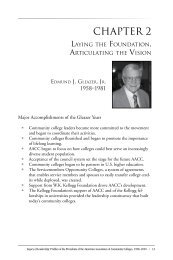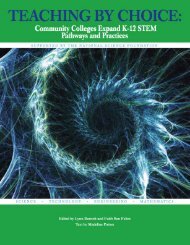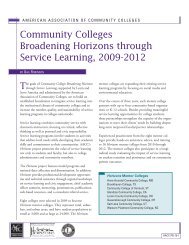2011 fact sheet - American Association of Community Colleges
2011 fact sheet - American Association of Community Colleges
2011 fact sheet - American Association of Community Colleges
You also want an ePaper? Increase the reach of your titles
YUMPU automatically turns print PDFs into web optimized ePapers that Google loves.
<strong>American</strong> <strong>Association</strong> <strong>of</strong> <strong>Community</strong> <strong>Colleges</strong><br />
<strong>2011</strong> <strong>Community</strong> College<br />
FAST FACTS<br />
One Dupont Circle, NW | Suite 410 | Washington, DC 20036 | T: 202-728-0200 | F: 202-833-2467 | www.aacc.nche.edu<br />
Promoting College Completion<br />
AACC is promoting the national goal to increase the number<br />
<strong>of</strong> students who complete degrees, certificates, and other<br />
credentials with value in the work place. AACC invites the<br />
nation’s 1,200 community colleges to join a call to action<br />
to engage community college institutions to advance 'the<br />
completion agenda' by pledging to increase student completion<br />
rates by 50 percent over the next decade. The completion<br />
theme underlies all <strong>of</strong> the association’s work in <strong>2011</strong>.<br />
FACT:<br />
“By 2018, we will need 22 million new college degrees—<br />
but will fall short <strong>of</strong> that number by at least 3 million<br />
postsecondary degrees, Associate’s or better. In addition,<br />
we will need at least 4.7 million new workers with<br />
postsecondary certificates.”<br />
— Carnevale, Smith, and Strohl (2010)<br />
AACC Embarks on 21st Century Initiative<br />
AACC’s President Walter Bumphus has embarked on a listening<br />
tour at 10 sites across the country to review the status <strong>of</strong><br />
community colleges, gauge the top issues confronting them,<br />
and establish a new vision for these institutions. During the<br />
tour, community college leaders will have the opportunity to<br />
talk about what they want from AACC and share best practices<br />
in areas such as developmental education, financial resources<br />
and research-based promising practices. Part <strong>of</strong> Bumphus’<br />
21st Century Initiative, the listening tour will culminate with a<br />
report on the future <strong>of</strong> community colleges, to be developed<br />
by a national commission and presented in 2012.<br />
Number and Type <strong>of</strong> <strong>Colleges</strong> 1<br />
Total . . . . . . . . . . . . . . . . . . . . . . . . . . . . . . . . . . . . . . . . . . 1,167<br />
Public . . . . . . . . . . . . . . . . . . . . . . . . . . . . . . . . . . . . . . . . . . 993<br />
Independent . . . . . . . . . . . . . . . . . . . . . . . . . . . . . . . . . . . . . 143<br />
Tribal . . . . . . . . . . . . . . . . . . . . . . . . . . . . . . . . . . . . . . . . . . . . 31<br />
Headcount Enrollment (fall 2008)<br />
Total . . . . . . . . . . . . . . . . . . . . . . . . . . . . . . . . . . . 12.4 million 2,3<br />
Credit . . . . . . . . . . . . . . . . . . . . . . . . . . . . . . . . . . . 7.4 million 2<br />
Noncredit . . . . . . . . . . . . . . . . . . . . . . . . . . . . . . . . . . 5 million 3<br />
Enrolled full time . . . . . . . . . . . . . . . . . . . . . . . . . . . . . . . . 40% 2<br />
Enrolled part time . . . . . . . . . . . . . . . . . . . . . . . . . . . . . . . 60% 2<br />
Estimated enrollment increase fall 2008–<br />
fall 2010: 15% 4<br />
Student Demographics<br />
2007–2008: 5<br />
Average age . . . . . . . . . . . . . . . . . . . . . . . . . . . . . . . . . . . . . . 28<br />
Median age . . . . . . . . . . . . . . . . . . . . . . . . . . . . . . . . . . . . . . . 23<br />
21 or younger . . . . . . . . . . . . . . . . . . . . . . . . . . . . . . . . . . . 39%<br />
22–39 . . . . . . . . . . . . . . . . . . . . . . . . . . . . . . . . . . . . . . . . . . 45%<br />
40 or older . . . . . . . . . . . . . . . . . . . . . . . . . . . . . . . . . . . . . . 15%<br />
First generation to attend college . . . . . . . . . . . . . . . . . . . 42%<br />
Single parents . . . . . . . . . . . . . . . . . . . . . . . . . . . . . . . . . . . 13%<br />
Non-U.S. citizens . . . . . . . . . . . . . . . . . . . . . . . . . . . . . . . . . . 6%<br />
Veterans . . . . . . . . . . . . . . . . . . . . . . . . . . . . . . . . . . . . . . . . . 3%<br />
Students with disabilities . . . . . . . . . . . . . . . . . . . . . . . . . . 12%<br />
Fall 2008: 2<br />
Women . . . . . . . . . . . . . . . . . . . . . . . . . . . . . . . . . . . . . . . .<br />
Men . . . . . . . . . . . . . . . . . . . . . . . . . . . . . . . . . . . . . . . . . . .<br />
Minorities . . . . . . . . . . . . . . . . . . . . . . . . . . . . . . . . . . . . . .<br />
Black . . . . . . . . . . . . . . . . . . . . . . . . . . . . . . . . . . . . . . . . . .<br />
Hispanic . . . . . . . . . . . . . . . . . . . . . . . . . . . . . . . . . . . . . . .<br />
Asian/Pacific Islander . . . . . . . . . . . . . . . . . . . . . . . . . . . . . .<br />
Native <strong>American</strong> . . . . . . . . . . . . . . . . . . . . . . . . . . . . . . . . . .<br />
58%<br />
42%<br />
45%<br />
13%<br />
16%<br />
6%<br />
1%<br />
<strong>Community</strong> college students constitute the<br />
following percentages <strong>of</strong> undergraduates (fall 2008): 2<br />
All U.S. undergraduates . . . . . . . . . . . . . . . . . . . . . . . . . . . 44%<br />
First-time freshmen . . . . . . . . . . . . . . . . . . . . . . . . . . . . . . 43%<br />
Native <strong>American</strong> . . . . . . . . . . . . . . . . . . . . . . . . . . . . . . . . . 55%<br />
Asian/Pacific Islander . . . . . . . . . . . . . . . . . . . . . . . . . . . . . 45%<br />
Black . . . . . . . . . . . . . . . . . . . . . . . . . . . . . . . . . . . . . . . . . . . 44%<br />
Hispanic . . . . . . . . . . . . . . . . . . . . . . . . . . . . . . . . . . . . . . . . 52%<br />
Employment Status (2007–2008) 5<br />
Full-time students employed full time . . . . . . . . . . . . . . . 21%<br />
Full-time students employed part time . . . . . . . . . . . . . . . 59%<br />
Part-time students employed full time . . . . . . . . . . . . . . . 40%<br />
Part-time students employed part time . . . . . . . . . . . . . . . 47%<br />
Percentage <strong>of</strong> Students Applying For/Receiving<br />
Financial Aid (2007–2008) 5<br />
Applied:<br />
Any aid . . . . . . . . . . . . . . . . . . . . . . . . . . . . . . . . . . . . . . . . . 59%<br />
Federal aid . . . . . . . . . . . . . . . . . . . . . . . . . . . . . . . . . . . . . . 42%<br />
Received:<br />
Any aid . . . . . . . . . . . . . . . . . . . . . . . . . . . . . . . . . . . . . . . . .<br />
Federal grants . . . . . . . . . . . . . . . . . . . . . . . . . . . . . . . . . . .<br />
Federal loans . . . . . . . . . . . . . . . . . . . . . . . . . . . . . . . . . . . .<br />
State aid . . . . . . . . . . . . . . . . . . . . . . . . . . . . . . . . . . . . . . . .<br />
Institutional aid . . . . . . . . . . . . . . . . . . . . . . . . . . . . . . . . . .<br />
Percentage <strong>of</strong> Federal Aid Received by<br />
<strong>Community</strong> <strong>Colleges</strong> (2008–2009) 6<br />
Average Annual Tuition and Fees (2010–<strong>2011</strong>) 7<br />
<strong>Community</strong> colleges (public, in district) . . . . . . . . . . . .<br />
4-year colleges (public, in state) . . . . . . . . . . . . . . . . . .<br />
Degrees and Certificates Awarded (2007–2008) 8<br />
Associate degrees . . . . . . . . . . . . . . . . . . . . . . . . . . . . . 609,016<br />
Certificates . . . . . . . . . . . . . . . . . . . . . . . . . . . . . . . . . . . 323,649<br />
Bachelor’s degrees—awarded by 48 public and<br />
82 independent colleges<br />
Revenue Sources (2007–2008) 9<br />
State funds . . . . . . . . . . . . . . . . . . . . . . . . . . . . . . . . . . . . . . 36%<br />
Local funds . . . . . . . . . . . . . . . . . . . . . . . . . . . . . . . . . . . . . . 19%<br />
Tuition and fees . . . . . . . . . . . . . . . . . . . . . . . . . . . . . . . . . . 16%<br />
Other . . . . . . . . . . . . . . . . . . . . . . . . . . . . . . . . . . . . . . . . . . 15%<br />
Federal funds . . . . . . . . . . . . . . . . . . . . . . . . . . . . . . . . . . . . 14%<br />
On-Campus Housing<br />
Available at 254 public and 62 independent colleges<br />
46%<br />
21%<br />
10%<br />
13%<br />
11%<br />
Pell Grants . . . . . . . . . . . . . . . . . . . . . . . . . . . . . . . . . . . . . . 31%<br />
Campus based aid . . . . . . . . . . . . . . . . . . . . . . . . . . . . . . . . 10%<br />
Academic competitiveness grants . . . . . . . . . . . . . . . . . . . 15%<br />
$2,713<br />
$7,605<br />
Sources<br />
1<br />
AACC membership database, January <strong>2011</strong>. ▪ 2 NCES. (2008). IPEDS Fall Enrollment Survey. [AACC analysis] ▪ 3 AACC membership database, 2006. [AACC analysis] ▪ 4 AACC 2009 and 2010 AACC fall<br />
enrollment surveys. [AACC analysis] ▪ 5 NCES. (2009). 2007–08 National Postsecondary Student Aid Study (NPSAS:08) [AACC analysis] ▪ 6 College Board. (2010). Trends in Student Aid: 2010. [AACC analysis] ▪<br />
7<br />
College Board. (2010). Trends in College Pricing: 2010. ▪ 8 NCES. (2008). IPEDS 2008 Completions Survey. [AACC analysis] ▪ 9 Knapp, Kelly-Reid, & Ginder. (2010). Enrollment in postsecondary institutions,<br />
fall 2008; graduation rates, 2002 and 2005 cohorts; and financial statistics, fiscal year 2008 (NCES 2010-152). ▪ 10 NCES. (2009). IPEDS 2009 Institutional Characteristics Survey. [AACC analysis]<br />
Note: Sources are presented in abbreviated format. Go to www.aacc.nche.edu/fast<strong>fact</strong>s for full citations.<br />
<strong>American</strong> <strong>Association</strong> <strong>of</strong> <strong>Community</strong> <strong>Colleges</strong><br />
<strong>2011</strong> <strong>fact</strong> <strong>sheet</strong><br />
Building a Nation <strong>of</strong> Learners by Advancing<br />
America’s <strong>Community</strong> <strong>Colleges</strong>
About AACC<br />
The <strong>American</strong> <strong>Association</strong> <strong>of</strong> <strong>Community</strong> <strong>Colleges</strong> (AACC)<br />
is the primary advocacy organization for the nation’s<br />
community colleges, representing nearly 1,200 two-year,<br />
associate degree–granting institutions and more than 11<br />
million students. Founded in 1920, AACC is a 501(c)(3)<br />
nonpr<strong>of</strong>it association. AACC is governed by a 32 member<br />
board <strong>of</strong> directors, elected for 3-year staggered terms.<br />
Twenty-six members are elected by the CEOs <strong>of</strong> AACC<br />
member institutions. The remaining six members are<br />
elected by the board and include three at large members<br />
and three public members representing constituencies<br />
such as boards <strong>of</strong> trustees, business, and government.<br />
AACC Leadership<br />
President and CEO:<br />
Walter G. Bumphus<br />
2010–<strong>2011</strong> Board Chair:<br />
John J. Sygielski<br />
President, Mt. Hood <strong>Community</strong> College<br />
2010–<strong>2011</strong> Chair-Elect:<br />
Myrtle B. Dorsey<br />
Chancellor, Baton Rouge <strong>Community</strong> College<br />
AACC Strategic Action Areas<br />
▪ Recognition and advocacy for community colleges<br />
▪ Student access, learning, and success<br />
▪ <strong>Community</strong> college leadership development<br />
▪ Economic and workforce development<br />
▪ Global and intercultural education<br />
AACC Advances <strong>Community</strong> <strong>Colleges</strong><br />
Leadership Development<br />
Every year, AACC <strong>of</strong>fers pr<strong>of</strong>essional development opportunities for<br />
members and other higher education pr<strong>of</strong>essionals to network and learn.<br />
▪ Annual Convention<br />
▪ Future Leaders Institute and Future Leaders Institute/Advanced<br />
▪ Presidents Academy: New CEO Institute and Summer Institute<br />
▪ Washington Institute<br />
▪ Workforce Development Institute<br />
For an expanded list <strong>of</strong> events, visit www.aacc.nche.edu, and click on<br />
News and Events.<br />
Legislation and Advocacy<br />
AACC monitors national policy, advocates for beneficial legislation, and<br />
informs its members about actions taken by Congress and key federal<br />
agencies. Among AACC’s current legislative priorities are increasing<br />
the Pell Grant maximum, bolstering funding for career and technical<br />
education programs, and reauthorizing the Workforce Investment Act.<br />
Read more at www.aacc.nche.edu/Advocacy.<br />
Student Success Programs<br />
AACC supports its members through a range <strong>of</strong> policy initiatives and<br />
innovative programs, such as<br />
▪ Achieving the Dream: <strong>Community</strong> <strong>Colleges</strong> Count<br />
▪ College Completion Challenge: A Call to Action<br />
▪ Minority Male Student Success<br />
▪ Service Learning<br />
▪ Voluntary Framework <strong>of</strong> Accountability<br />
Read more at www.aacc.nche.edu/resources/aaccprograms.<br />
Stay in Touch<br />
AACC produces print and electronic publications to help you to stay on<br />
top <strong>of</strong> the constantly evolving community college environment.<br />
▪ www.aacc.nche.edu—AACC’s website is the premier portal to<br />
up-to-date information about AACC and the nation’s community<br />
colleges. Some <strong>of</strong> the top resources visitors are looking at:<br />
▪ Annual Convention and other event information<br />
▪ <strong>Community</strong> College Finder<br />
▪ Job listings<br />
▪ Trends and statistics<br />
▪ <strong>Community</strong> College Journal is the single most important publication<br />
for community college leaders. Covers trends, the latest issues, and<br />
opinions. Offered in print and as a digital magazine.<br />
Access at www.aacc.nche.edu/publications.<br />
▪ <strong>Community</strong> College Press publishes practical books from higher<br />
education thought-leaders; reports and monographs; and<br />
project, research, and policy briefs.<br />
Access at www.aacc.nche.edu/publications.<br />
▪ For today’s news, read AACC’s online newspaper, <strong>Community</strong> College<br />
Times. Features commentary, job listings, and a free daily digest.<br />
Free access at www.<strong>Community</strong>CollegeTimes.com.<br />
▪ Join the conversation on social media.<br />
www.twitter.com/Comm_College<br />
www.Facebook.com/CommCollege<br />
AACC serves 1,167 community,<br />
junior, and technical colleges.<br />
Personnel: 61 full- and part-time employees<br />
2010 Operating Budget: $8.2 million<br />
AACC <strong>2011</strong> Budget<br />
Revenue (Total - $15,578,000)<br />
Grants and<br />
contracts – 48%<br />
Membership – 38%<br />
Expenditures (Total - 14,984,300)<br />
Grants and<br />
contracts – 50%<br />
International services – 5%<br />
Publications – 4%<br />
Convention (net) – 2%<br />
Seminars and worskshops – 2%<br />
Policy development and advocacy – 13%<br />
Investment income – 2%<br />
Other revenue – 1%<br />
Healthcare Virtual Careers Platform<br />
The Healthcare Virtual Careers Platform (HVCP) will help<br />
un- and underemployed people transition into health-care<br />
careers, where significant shortages exist. Individual users<br />
will be empowered to explore health-care careers, choose<br />
a potential career target, locate and enroll in training or<br />
instructional programs, and make the career transition. As<br />
a major player in health-care career training, community<br />
colleges will be enabled to deliver free online remedial<br />
courses and to identify online and classroom courses that<br />
lead to health-care–related credentials. AACC is building<br />
HVCP as an open source, open content, platform through a<br />
$6.6 million grant from the U.S. Department <strong>of</strong> Labor.<br />
FACT:<br />
Half <strong>of</strong> all new nurses and the majority <strong>of</strong> other new health-care<br />
workers are educated at community colleges.<br />
Workforce Development Initiatives<br />
<strong>Community</strong> colleges are training and retraining <strong>American</strong>s so they can<br />
go back to work, through initiatives such as<br />
www.linkedin.com<br />
Search for <strong>American</strong> <strong>Association</strong> <strong>of</strong> <strong>Community</strong><br />
<strong>Colleges</strong> under Companies<br />
Publications – 7%<br />
International services – 5%<br />
FACTS:<br />
Over 91,000 international students attend community<br />
colleges—about 33% <strong>of</strong> all international students in the United<br />
States.<br />
Between fall 2008 and fall 2010, community college enrollment<br />
increased by over 1 million students.<br />
▪ Advanced Technological Education<br />
(through National Science Foundation)<br />
▪ Center for Workforce and Economic Development<br />
▪ Health Pr<strong>of</strong>essions Education Center<br />
▪ Plus 50 Initiative<br />
▪ SEED Center<br />
Corporate Program<br />
Through its Corporate Program, AACC directly links with over 40<br />
businesses and foundations in support for many <strong>of</strong> AACC’s programs<br />
and strengthens the alliances these organizations have with<br />
community colleges.<br />
In the News<br />
www.youtube.com/communitycolleges<br />
<strong>Community</strong> colleges have garnered unprecedented media attention,<br />
focused largely around dramatic enrollment growth and support for<br />
economic recovery. AACC responds or contributes to major stories via<br />
national media including CNN, ABC, CBS, and NPR and in the New York<br />
Times, USA Today, Wall Street Journal, and the Washington Post.<br />
Contact AACC<br />
For a complete directory <strong>of</strong> departments and staff, go to<br />
www.aacc.nche.edu. Click on “About AACC”.<br />
<strong>American</strong> <strong>Association</strong> <strong>of</strong> <strong>Community</strong> <strong>Colleges</strong><br />
One Dupont Circle NW, Suite 410 | Washington, DC 20036<br />
Phone: 202-728‐0200 | Fax: 202-833‐2467 or 202-223‐9390<br />
Internet: www.aacc.nche.edu<br />
Communications and public relations – 3%<br />
Member support services – 3%<br />
Workforce and economic development – 3%<br />
Academic, student, and community development – 2%<br />
Leadership development – 2%<br />
General and administrative – 7%<br />
Web and technical services – 5%<br />
Fundraising – 2%<br />
<strong>Community</strong> College and Career Training<br />
Grants Program<br />
Called “the largest investment in two-year institutions<br />
since the G.I. Bill” by Education Secretary Arne Duncan, the<br />
<strong>Community</strong> College and Career Training Grants Program has<br />
made available $2 billion over four years to colleges that<br />
<strong>of</strong>fer academic programs <strong>of</strong> two years or less in duration.<br />
The grants will be used for retraining trade-displaced<br />
workers and the development and use <strong>of</strong> evidence-based<br />
learning materials, including shared courses and open<br />
resources that would be available online for free.


